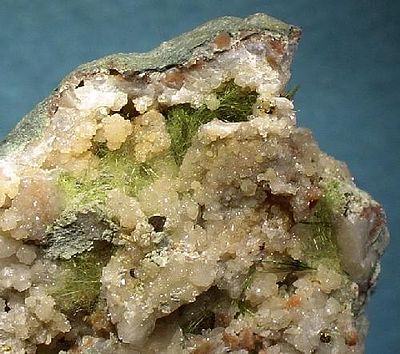Jamborite
| Jamborite | |
|---|---|
| Jamborite from Halls Gap, Lincoln County, Kentucky, USA | |
| General and classification | |
| other names |
IMA 1971-037 |
| chemical formula | (Ni 2+ , Ni 3+ , Co, Fe 2+ , Fe 3+ ) (OH) 2 (OH, S, H 2 O) |
|
Mineral class (and possibly department) |
Oxides and hydroxides |
|
System no. to Strunz and to Dana |
4.FL.05 ( 8th edition : IV / F.04) 03/06/08/01 |
| Crystallographic Data | |
| Crystal system | hexagonal |
| Crystal class ; symbol | not defined |
| Lattice parameters | a = 3.07 Å ; c = 23.3 Å |
| Formula units | Z = 3 |
| Physical Properties | |
| Mohs hardness | not defined |
| Density (g / cm 3 ) | 2.67 |
| Cleavage | Please complete |
| colour | green |
| Line color | not defined |
| transparency | translucent |
| shine | Please complete |
| Crystal optics | |
| Refractive indices |
n ω = 1.607 n ε = 1.602 |
| Birefringence | δ = 0.005 |
| Optical character | uniaxial negative |
| Other properties | |
| Special features | insoluble in water; slightly soluble in cold hydrochloric acid |
Jamborite is a rarely occurring mineral from the mineral class of " oxides and hydroxides ". It crystallizes in the hexagonal crystal system with the chemical composition (Ni 2+ , Ni 3+ , Co, Fe 2+ , Fe 3+ ) (OH) 2 (OH, S, H 2 O) and usually develops translucent green, needle-like to fibrous Crystals and pseudomorphs according to Millerite .
Etymology and history
Jamborite was discovered in 1971 at three different sites in the northern Italian region of Emilia-Romagna : Ca 'dei Ladri (Silla) in Gaggio Montano and on Monte Acuto Ragazza in Grizzana Morandi ( Metropolitan City of Bologna ) and Sasso delle Lucine in Montese . These are also considered type localities .
The mineral was scientifically described by N. Morandi and G. Darlio, who named the mineral after the Canadian mineralogist John Leslie Jambor (1936-2008) and who submitted their results to the International Mineralogical Association (IMA) for examination. This recognized the mineral in the same year under the internal accession number IMA 1971-037 as independent.
classification
In the now outdated, but still in use 8th edition of the mineral classification according to Strunz , the jamborite belonged to the mineral class of "oxides and hydroxides" and there to the department of "hydroxides and oxidic hydrates", where together with brandholzite and bottinoite it belongs to the unnamed group IV / F.04 made.
The 9th edition of Strunz's mineral systematics , which has been in effect since 2001 and is used by the IMA, also assigns Jamborite to the class of "oxides and hydroxides", but in the separate division of "hydroxides (without V or U)". This division is also more precisely subdivided according to the presence or absence of crystal water or hydroxide ions (OH) and the crystal structure, so that the mineral is classified according to its composition and structure in the sub-division of “Hydroxides with H 2 O ± (OH); Layers of edge-linked octahedra ”can be found where it forms the unnamed group 4.FL.05 together with fougèrit , Iowaite , meixnerite , muskoxite and woodallite .
The systematics of minerals according to Dana also assigns jamborite to the class of "oxides and hydroxides" and there into the department of "hydroxides and hydroxides containing oxides". Here he is the only member of the unnamed group 06.03.08 within the sub-section “ Hydroxides and hydroxides containing (OH) 3 or (OH) 6 groups ”.
Crystal structure
Jamborite crystallizes hexagonally in a previously undefined space group with the lattice parameters a = 3.07 Å and c = 23.3 Å as well as 3 formula units per unit cell .
properties
Jamborite is insoluble in water and only slightly soluble in cold hydrochloric acid .
Education and Locations
Jamborite is secondary to the transformation of millerite under hydrothermal conditions . In addition to millerite, accompanying minerals include calcite , dolomite and quartz (in Italy) as well as gaspéite , glaucoma and mcguinnessite (in Japan).
So far (as of 2010) Jamborite has been found at around 20 sites worldwide. In Italy, in addition to its type localities in the Emilia-Romagna region, the mineral was also found near Groppallo ( Piacenza province ) and in the "S'Acqua is Prunas Mine" near Gonnosfanadiga ( Medio Campidano province , Sardinia) and at several sites in Tuscany .
Other locations are the “Nakauri Mine” near Shinshiro in Japan, the “Palhal Mine” near Albergaria-a-Velha in Portugal, the “Nueva Virginia Mine” near Lanzuela ( Aragon ) and “Eugenia Mine” ( Catalonia ) in Spain "Bryn-yr-Afr mine" and the mine "Coed Ely" in Wales (UK) and Harrodsburg ( Indiana ) and Halls Gap (Kentucky) in the US.
See also
Web links
- Mineral Atlas: Jamborite (Wiki)
- N. Morandi, G. Darlio: Jamborite: A New Nickel Hydroxide Mineral From the Northern Apennines, Italy . In: American Mineralogist , Volume 58, pages 835–839, 1973 (English, PDF 602.8 kB)
- Handbook of Mineralogy - Jamborite (English, PDF 65.2 kB)
Individual evidence
- ↑ a b Webmineral - Jamborite (English)
- ↑ a b c Jamborite at mindat.org (engl.)
